A Review of Energy Storage Technologies’ Application Potentials in Renewable Energy Sources Grid Integration
Abstract
:1. Introduction
2. Methodology of Reviewing Literature and Selecting ESTs
- Up-to-date technical details and characteristics data for all selected ESTs have been collected from several peer-reviewed journal papers.
- To evaluate the application potential of ESTs for RESs utility grid integration clearly, all selected characteristics of ESTs are graphically compared and analyzed.
- Using graphic comparison results, the application potential of ESTs categorizations has been decided by comparing with Table 1, by considering the common characteristics of ESTs and their application area requirements.
3. Overview of Energy Storage Technologies
3.1. Mechanical Energy Storage
3.2. Electrical Energy Storage
3.3. Electrochemical Energy Storage
4. Overall Comparison of Energy Storage Technologies
4.1. Technical Criteria
4.1.1. Energy and Power Density of ESTs Comparison Result
4.1.2. Power Rating and Discharge Time of ESTs Comparison Result
4.1.3. Self-Discharge Time of ESTs Comparison Result
4.1.4. Lifetime of ESTs Comparison Result
4.1.5. Technological Maturity of ESTs Comparison Result
4.1.6. Round-Trip Efficiency of ESTs Comparison Result
4.1.7. Response Time of ESTs Comparison Result
4.2. Economics Criteria
Capital and Operating Costs of ESTs Comparison Result
4.3. Environmental Criteria
Impact on Environment of ESTs Comparison Result
5. Discussion
- Electrochemical energy storage systems have higher energy density than others: As shown in Figure 3, compared to all selected ESTs, electrochemical energy storage systems (Pb-A, Ni-Cd, Na-S, NaNiCl2, and Li-ion) have higher energy density than others, which allows them to provide more energy over a long duration. Among the electrochemical energy storage system, Li-ion battery has both a higher energy density (350 Wh/l) and power density (1250 W/l), which makes it lighter in weight and smaller in size than other rechargeable batteries. In contrast, the power density of SCES (2750 W/l), SMES (2500 W/l), and FES (1500 W/l) are higher than other types of ESTs, which allows them to provide more power over a short duration. Such types of ESTs are very important in the renewable energy generation sector such as for power fluctuation mitigation application.
- PHS and CAES have a higher power range and longer discharge time than others: As indicated in Figure 4 and Table 1, the storage mediums with large discharge time and very high power range, such as PHS and CAES are more suitable for energy management for large scale application. The typical power rating and discharge time duration for this kind of application is above 300 MW and hourly to days duration respectively. In addition to this, large-scale batteries such as Pb-A, Ni-Cd, Li-ion, and VRFB are more suitable for medium-scale energy management (bridging power) applications. Similarly, the typical power rating and discharge time duration for this kind of application is 10–100 MW and minute to hours duration, respectively. Moreover, ESTs with short discharge time (seconds) such as SMES, FES, and SCES are more suitable for power quality and regulation application.
- PHS, CAES, and VRFB have a very small (negligible) daily self-discharge time than others: As illustrated in Figure 5, PHS, CAES, and VRFB have a very small (almost negligible) daily self-discharge ratio compare to other types of ESTs. Therefore, such types of energy storage systems are more suitable for long storage duration applications such as energy management applications. Among the electrochemical energy storage system, Na-S and NaNiCl2 have the highest self-discharge rate of 20% and 19.07% per day, respectively. Moreover, compared to all selected ESTs, FES has the highest self-discharge rate of 74.67% per day. Similarly, SMES and SCES also have the highest self-discharge rate of 10.25% and 25.115% per day, respectively. Thus, such types of energy storage systems are more suitable for short time duration application (power quality and regulation) applications.
- PHS and CAES have a longer life than others: As illustrated in 6, the mechanical energy storage system (PHS and CAES) have a longer lifetime than electrochemical and electrical energy storage system. Compare to all selected ESTs, PHS has the largest life span of 50 years, while electrochemical energy storage systems are fall within the range of 7.5–15 years. Compared to the mechanical and electrical energy storage system, the electrochemical energy storage system usually has a short lifetime due to rapid recharging, and the effect of working in high temperatures.
- PHS, Pb-A, and Ni-Cd battery are the most matured technology than others: As shown in Figure 7, PHS, Pb-A, and Ni-Cd battery are the most matured and fully commercialized ESTs compared to others and have been used for over 100 years. On the other hand, CAES, Na-S, NaNiCl2, Li-ion, VRFB, SMES, SCES, FES are proven and commercializing technologies.
- FES, SMES, SECES, and Li-ion batteries have very high round-trip efficiency than others: As shown in Figure 8, the round-trip efficiency of FES, SMES, SCES, and Li-ion batteries have a very high round-trip efficiency of above 90%, which are the top amongst ESTs. PHS, CAES, and electrochemical energy storage systems (Pb-A, Ni-Cd, Na-S, VRFB, and NaNiCl2), have high round-trip efficiency in the range of 74.5–90%.
- PHS and CAES have the lowest capital cost per kWh than others: As indicated in Figure 10, among all selected ESTs, the capital cost per kWh of PHS (147.5$/kWh) and CAES (100.4$/kWh) are in the low range. However, FES, SMES, and SCES have a higher capital cost per kWh. On the contrary, FES, SMES, and SCES have a lower capital cost per kW, such type of ESTs is applicable when higher power outputs are required.
- FES and SCES have a very low environmental impact than others: As shown in Figure 11, PHS, CAES, batteries, and SMES have high negative impacts on the environment, whereas, FES and SCES have a very small environmental impact.
6. Conclusions
Author Contributions
Funding
Acknowledgments
Conflicts of Interest
References
- IRENA. Renewable Energy Capacity Highlights; Irena: New York, NY, USA, 2020. [Google Scholar]
- Das, C.K.; Bass, O.; Kothapalli, G.; Mahmoud, T.S.; Habibi, D. Overview of energy storage systems in distribution networks: Placement, sizing, operation, and power quality. Renew. Sustain. Energy Rev. 2018, 91, 1205–1230. [Google Scholar] [CrossRef]
- Palizban, O.; Kauhaniemi, K. Energy storage systems in modern grids—Matrix of technologies and applications. J. Energy Storage 2016, 6, 248–259. [Google Scholar] [CrossRef]
- Hadjipaschalis, I.; Poullikkas, A.; Efthimiou, V. Overview of current and future energy storage technologies for electric power applications. Renew. Sustain. Energy Rev. 2009, 13, 1513–1522. [Google Scholar] [CrossRef]
- Yao, L.; Yang, B.; Cui, H.; Zhuang, J.; Ye, J.; Xue, J. Challenges and progresses of energy storage technology and its application in power systems. J. Mod. Power Syst. Clean Energy 2016, 4, 519–528. [Google Scholar] [CrossRef] [Green Version]
- China Energy Storage Allliance (CNESA). CNESA Global Energy Storage Market Analysis—2019.Q4 (Summary). 2020. Available online: http://en.cnesa.org/latest-news/2020/5/28/cnesa-global-energy-storage-market-analysis-2020q1-summary (accessed on 15 October 2020).
- Leadbetter, J.; Swan, L.G. Selection of battery technology to support grid-integrated renewable electricity. J. Power Sources 2012, 216, 376–386. [Google Scholar] [CrossRef]
- Johal, H.; Manz, D.; O’Brien, K.; Kern, J. Grid integration of energy storage. In Proceedings of the 2011 IEEE Power and Energy Society General Meeting, Detroit, MI, USA, 24–28 July 2011; pp. 1–2. [Google Scholar] [CrossRef]
- Sabihuddin, S.; Kiprakis, A.E.; Mueller, M. A numerical and graphical review of energy storage technologies. Energies 2015, 8, 172–216. [Google Scholar] [CrossRef]
- Denholm, P.; Ela, E.; Kirby, B.; Milligan, M. The role of energy storage with renewable electricity generation. In Energy Storage: Issues and Applications; NREL: Oak Ridge, TN, USA, 2011; pp. 1–58. [Google Scholar]
- Luo, X.; Wang, J.; Dooner, M.; Clarke, J. Overview of current development in electrical energy storage technologies and the application potential in power system operation. Appl. Energy 2015, 137, 511–536. [Google Scholar] [CrossRef] [Green Version]
- Rohit, A.K.; Rangnekar, S. An overview of energy storage and its importance in Indian renewable energy sector: Part II—Energy storage applications, benefits and market potential. J. Energy Storage 2017, 13, 447–456. [Google Scholar] [CrossRef]
- Chen, H.; Cong, T.N.; Yang, W.; Tan, C.; Li, Y.; Ding, Y. Progress in electrical energy storage system: A critical review. Prog. Nat. Sci. 2009, 19, 291–312. [Google Scholar] [CrossRef]
- Nadeem, F.; Hussain, S.M.S.; Tiwari, P.K.; Goswami, A.K.; Ustun, T.S. Comparative review of energy storage systems, their roles, and impacts on future power systems. IEEE Access 2019, 7, 4555–4585. [Google Scholar] [CrossRef]
- Ibrahim, H.; Ilinca, A.; Perron, J. Energy storage systems-Characteristics and comparisons. Renew. Sustain. Energy Rev. 2008, 12, 1221–1250. [Google Scholar] [CrossRef]
- Díaz-González, F.; Sumper, A.; Gomis-Bellmunt, O.; Villafáfila-Robles, R. A review of energy storage technologies for wind power applications. Renew. Sustain. Energy Rev. 2012, 16, 2154–2171. [Google Scholar] [CrossRef]
- Zhao, H.; Wu, Q.; Hu, S.; Xu, H.; Rasmussen, C.N. Review of energy storage system for wind power integration support. Appl. Energy 2015, 137, 545–553. [Google Scholar] [CrossRef]
- Maisanam, A.K.S.; Biswas, A.; Sharma, K.K. An innovative framework for electrical energy storage system selection for remote area electrification with renewable energy system: Case of a remote village in India. J. Renew. Sustain. Energy 2020, 12. [Google Scholar] [CrossRef]
- Koohi-Fayegh, S.; Rosen, M.A. A review of energy storage types, applications and recent developments. J. Energy Storage 2020, 27. [Google Scholar] [CrossRef]
- Acar, C. A comprehensive evaluation of energy storage options for better sustainability. Int. J. Energy Res. 2018, 42, 3732–3746. [Google Scholar] [CrossRef]
- Liu, Y.; Du, J.L. A multi criteria decision support framework for renewable energy storage technology selection. J. Clean. Prod. 2020, 277. [Google Scholar] [CrossRef]
- Rahman, M.M.; Oni, A.O.; Gemechu, E.; Kumar, A. Assessment of energy storage technologies: A review. Energy Convers. Manag. 2020, 223. [Google Scholar] [CrossRef]
- Thomas, D.; D’Hoop, G.; Deblecker, O.; Genikomsakis, K.N.; Ioakimidis, C.S. An integrated tool for optimal energy scheduling and power quality improvement of a microgrid under multiple demand response schemes. Appl. Energy 2020, 260. [Google Scholar] [CrossRef] [Green Version]
- Thomas, D.; Kazempour, J.; Papakonstantinou, A.; Pinson, P.; Deblecker, O.; Ioakimidis, C.S. A Local Market Mechanism for Physical Storage Rights. IEEE Trans. Power Syst. 2020, 35, 3087–3099. [Google Scholar] [CrossRef] [Green Version]
- Kebede, A.A.; Berecibar, M.; Coosemans, T.; Messagie, M.; Jemal, T.; Behabtu, H.A.; Van Mierlo, J. A techno-economic optimization and performance assessment of a 10 kWP photovoltaic grid-connected system. Sustain. 2020, 12, 7648. [Google Scholar] [CrossRef]
- Aneke, M.; Wang, M. Energy storage technologies and real life applications—A state of the art review. Appl. Energy 2016, 179, 350–377. [Google Scholar] [CrossRef] [Green Version]
- Ben Elghali, S.; Outbib, R.; Benbouzid, M. Selecting and optimal sizing of hybridized energy storage systems for tidal energy integration into power grid. J. Mod. Power Syst. Clean Energy 2019, 7, 113–122. [Google Scholar] [CrossRef]
- IEC. IEC Electrical Energy Storage White Paper. 2009. Available online: https://www.iec.ch/whitepaper/energystorage/ (accessed on 24 October 2020).
- Khalid, M. A review on the selected applications of battery-supercapacitor hybrid energy storage systems for microgrids. Energies 2019, 12, 4559. [Google Scholar] [CrossRef] [Green Version]
- Mallick, K.; Das, S.; Sengupta, A.; Chattaraj, S. Modern Mechanical Energy Storage Systems and Technologies. Int. J. Eng. Res. 2016, V5, 727–730. [Google Scholar] [CrossRef]
- Kampouris, K.P.; Drosou, V.; Karytsas, C.; Karagiorgas, M. Energy storage systems review and case study in the residential sector. IOP Conf. Ser. Earth Environ. Sci. 2020, 410. [Google Scholar] [CrossRef]
- Amiryar, M.E.; Pullen, K.R. A review of flywheel energy storage system technologies and their applications. Appl. Sci. 2017, 7, 286. [Google Scholar] [CrossRef] [Green Version]
- Salkuti, S.R.; Jung, C.M. Comparative analysis of storage techniques for a grid with renewable energy sources. Int. J. Eng. Technol. 2018, 7, 970–976. [Google Scholar] [CrossRef]
- Argyrou, M.C.; Christodoulides, P.; Wongwises, S.A. Energy storage for electricity generation and related processes: Technologies appraisal and grid scale applications. Renew. Sustain. Energy Rev. 2018, 94, 804–821. [Google Scholar] [CrossRef]
- Molina, M.G. Energy Storage and Power Electronics Technologies: A Strong Combination to Empower the Transformation to the Smart Grid. Proc. IEEE 2017, 105, 2191–2219. [Google Scholar] [CrossRef]
- Swierczynski, M.; Teodorescu, R.; Rasmussen, C.N.; Rodriguez, P.; Vikelgaard, H. Overview of the energy storage systems for wind power integration enhancement. In Proceedings of the 2010 IEEE International Symposium on Industrial Electronics, Bari, Italy, 4 July 2010; pp. 3749–3756. [Google Scholar] [CrossRef] [Green Version]
- Suvire, G.O.; Mercado, P.E.; Ontiveros, L.J. Comparative analysis of energy storage technologies to compensate wind power short-term fluctuations. In Proceedings of the 2010 IEEE/PES Transmission and Distribution Conference and Exposition: Latin America, T and D-LA 2010, São Paulo, Brazil, 8–10 November 2010; pp. 522–528. [Google Scholar] [CrossRef]
- Asian Development Bank. Handbook on Battery Energy Storage System; ADB: Mandaluyong, Phillippines, 2018. [Google Scholar]
- Evans, A.; Strezov, V.; Evans, T.J. Assessment of utility energy storage options for increased renewable energy penetration. Sustain. Energy Rev. 2012, 16, 4141–4147. [Google Scholar] [CrossRef]
- Stroe, D.I.; Stan, A.I.; Diosi, R.; Teodorescu, R.; Andreasen, S.J. Short term energy storage for grid support in wind power applications. In Proceedings of the 2012 13th International Conference on Optimization of Electrical and Electronic Equipment (OPTIM), Brasov, Romania, 24–26 2012 May; pp. 1012–1021. [Google Scholar] [CrossRef]
- Mongird, K.; Viswanathan, V.V.; Balducci, P.J.; Alam, M.J.E.; Fotedar, V.; Koritarov, V.S.; Hadjerioua, B. Energy Storage Technology and Cost Characterization Report. 2019. Available online: https://www.energy.gov/sites/prod/files/2019/07/f65/Storage%20Cost%20and%20Performance%20Characterization%20Report_Final.pdf (accessed on 15 July 2020).
- Yekini Suberu, M.; Wazir Mustafa, M.; Bashir, N. Energy storage systems for renewable energy power sector integration and mitigation of intermittency. Renew. Sustain. Energy Rev. 2014, 35, 499–514. [Google Scholar] [CrossRef]
- Sufyan, M.; Rahim, N.A.; Aman, M.M.; Tan, C.K.; Raihan, S.R.S. Sizing and applications of battery energy storage technologies in smart grid system: A review. J. Renew. Sustain. Energy 2019, 11. [Google Scholar] [CrossRef]
- Pomper, D.E. Electricity Storage: Technologies and Applications. 2010. Available online: http://nrri.org/?wpdmdl=700 (accessed on 24 September 2020).
- Chowdhury, M.M.; Haque, M.; Aktarujjaman, M.; Negnevitsky, M.; Gargoom, A. Grid integration impacts and energy storage systems for wind energy applications—A review. In Proceedings of the 2011 IEEE Power and Energy Society General Meeting, Detroit, MI, USA, 24–28 July 2011; pp. 1–8. [Google Scholar] [CrossRef]
- Farhadi, M.; Mohammed, O. Energy Storage Technologies for High-Power Applications. IEEE Trans. Ind. Appl. 2016, 52, 1953–1961. [Google Scholar] [CrossRef]

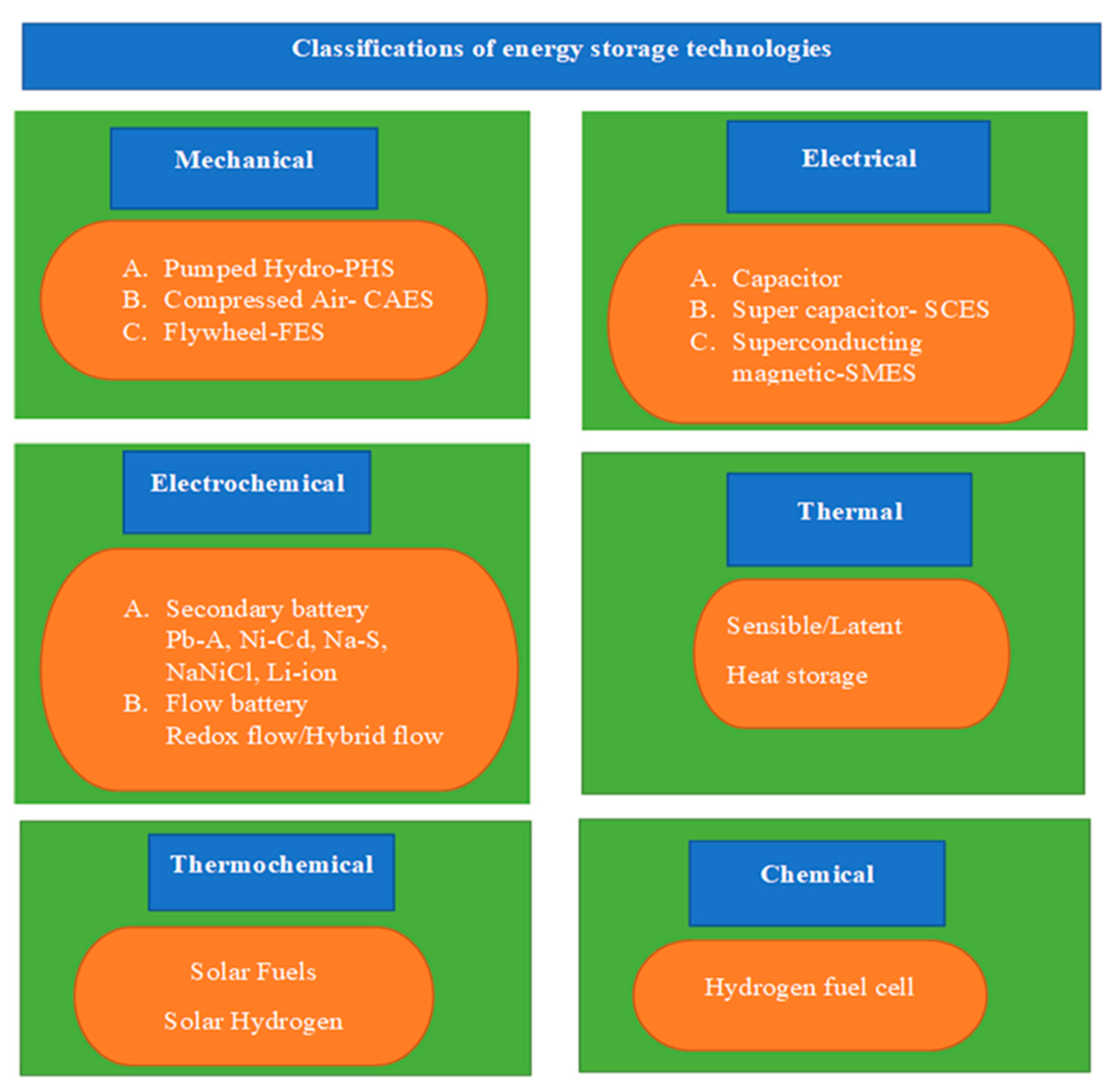

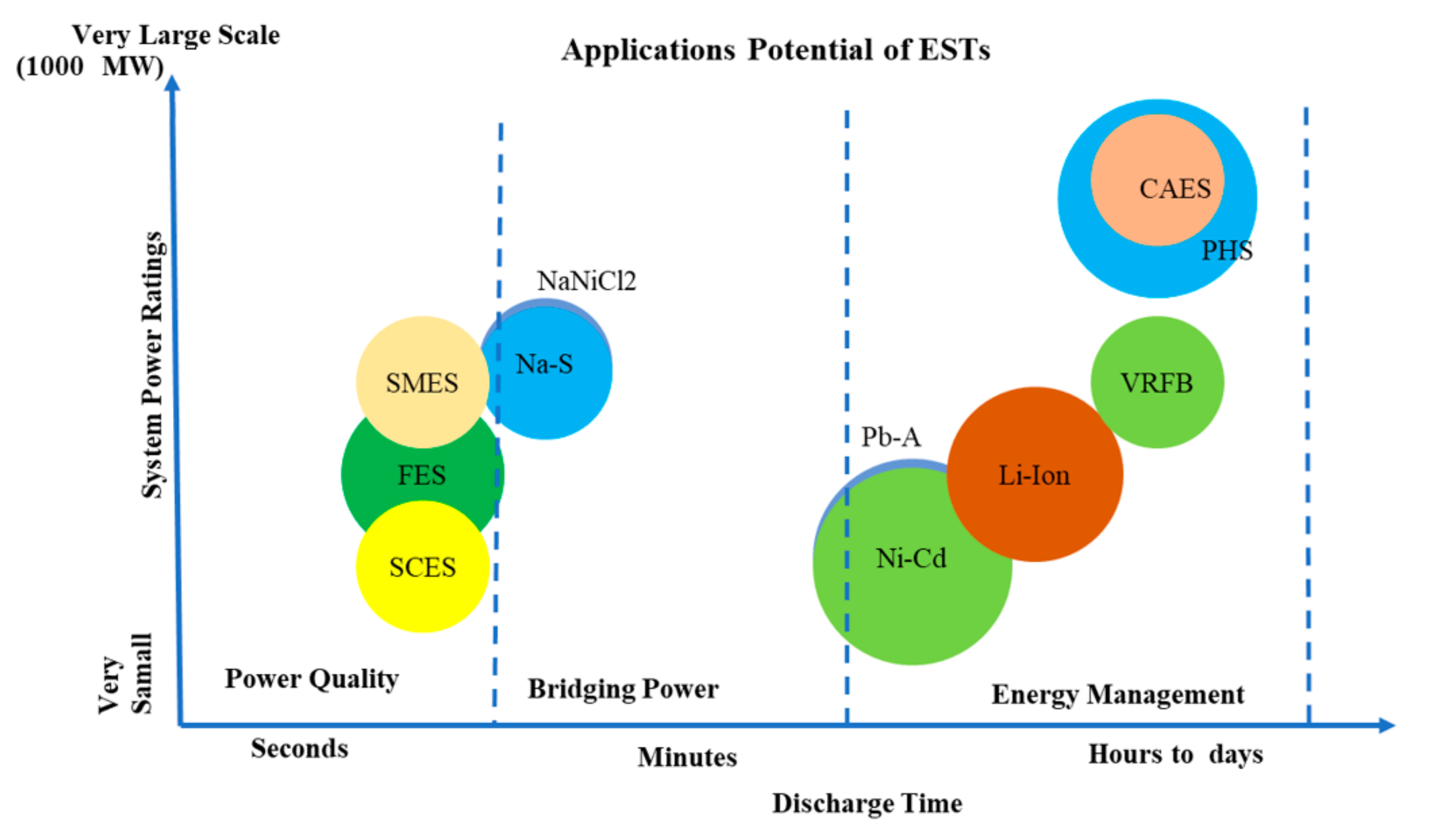



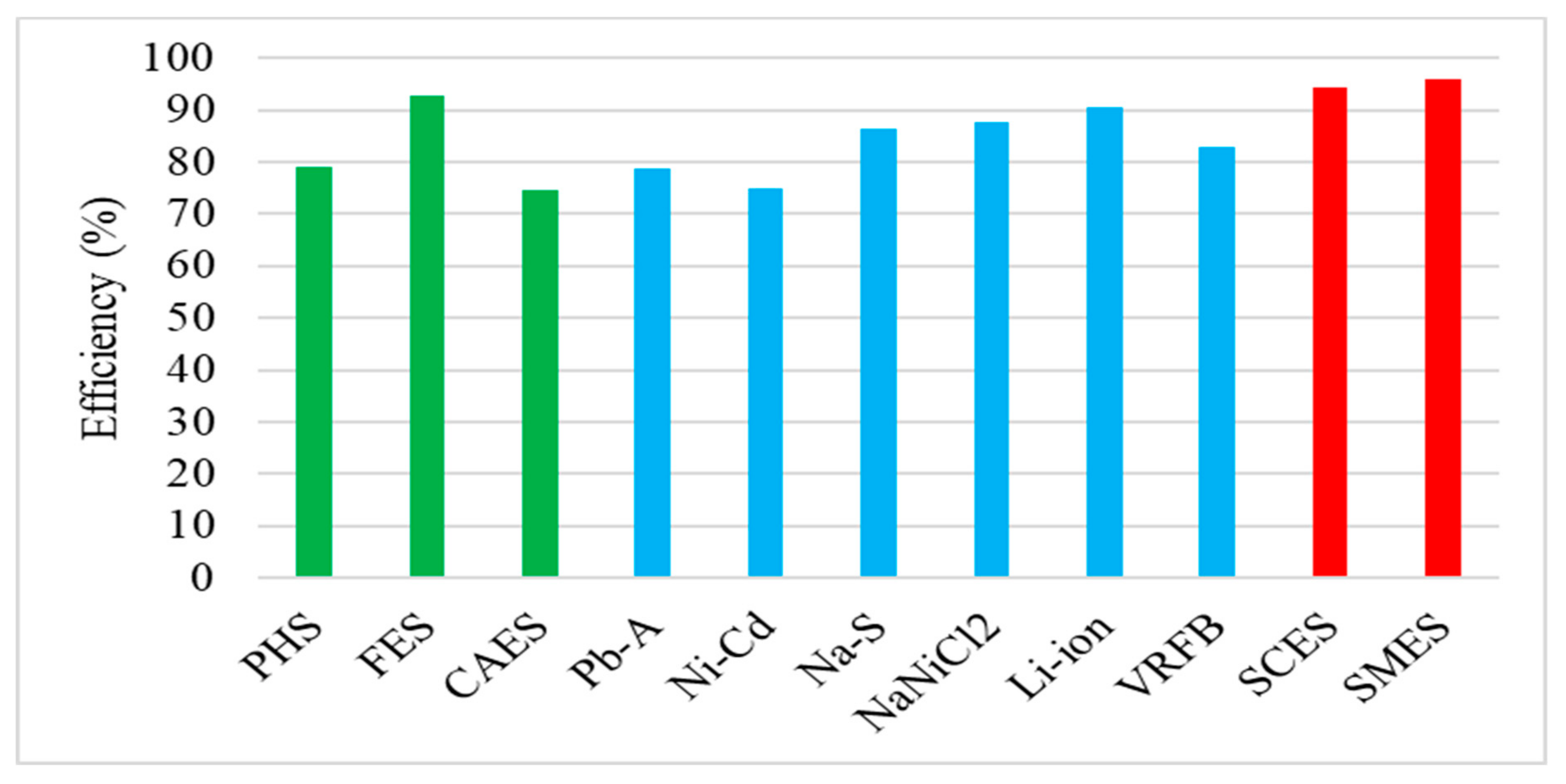
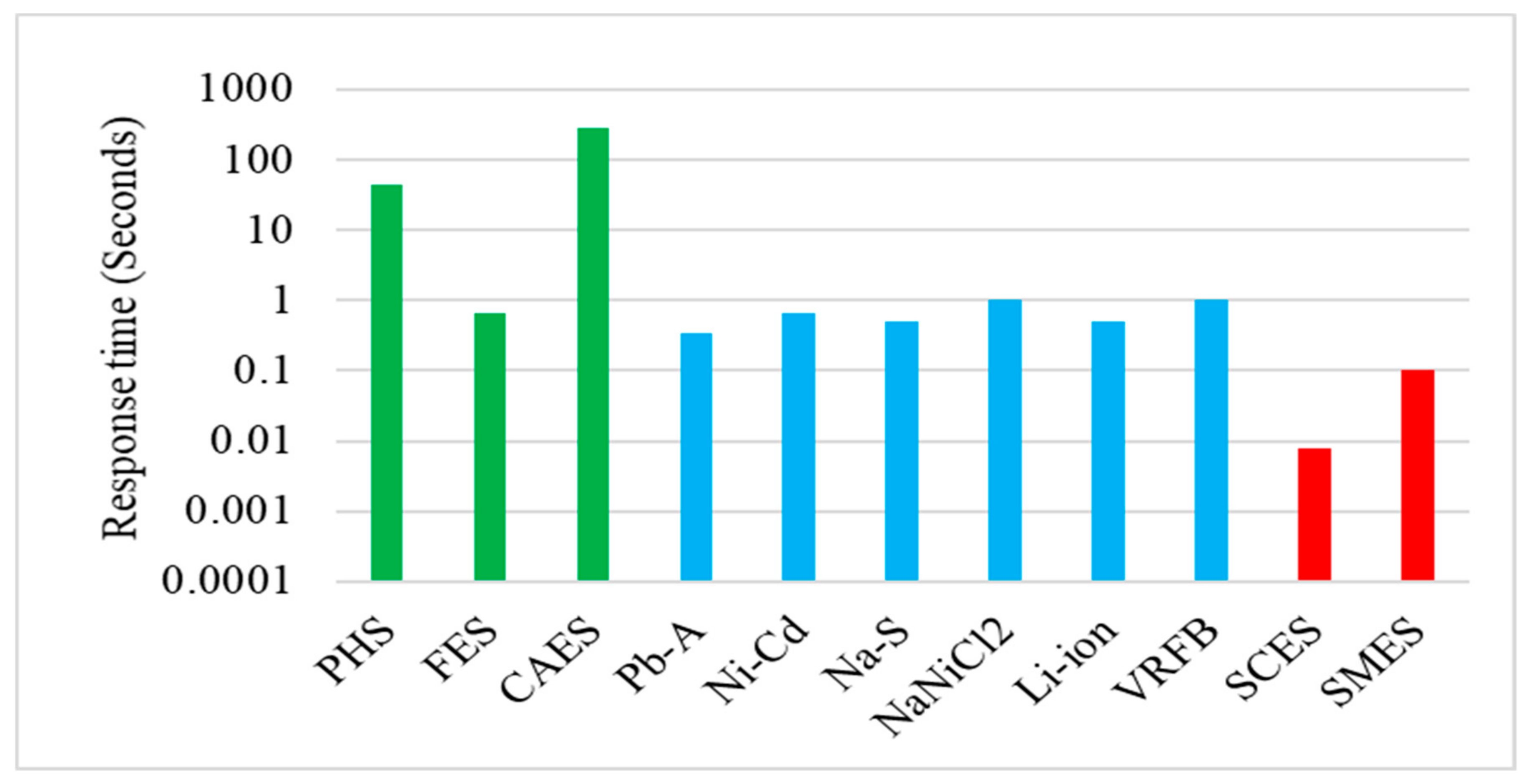
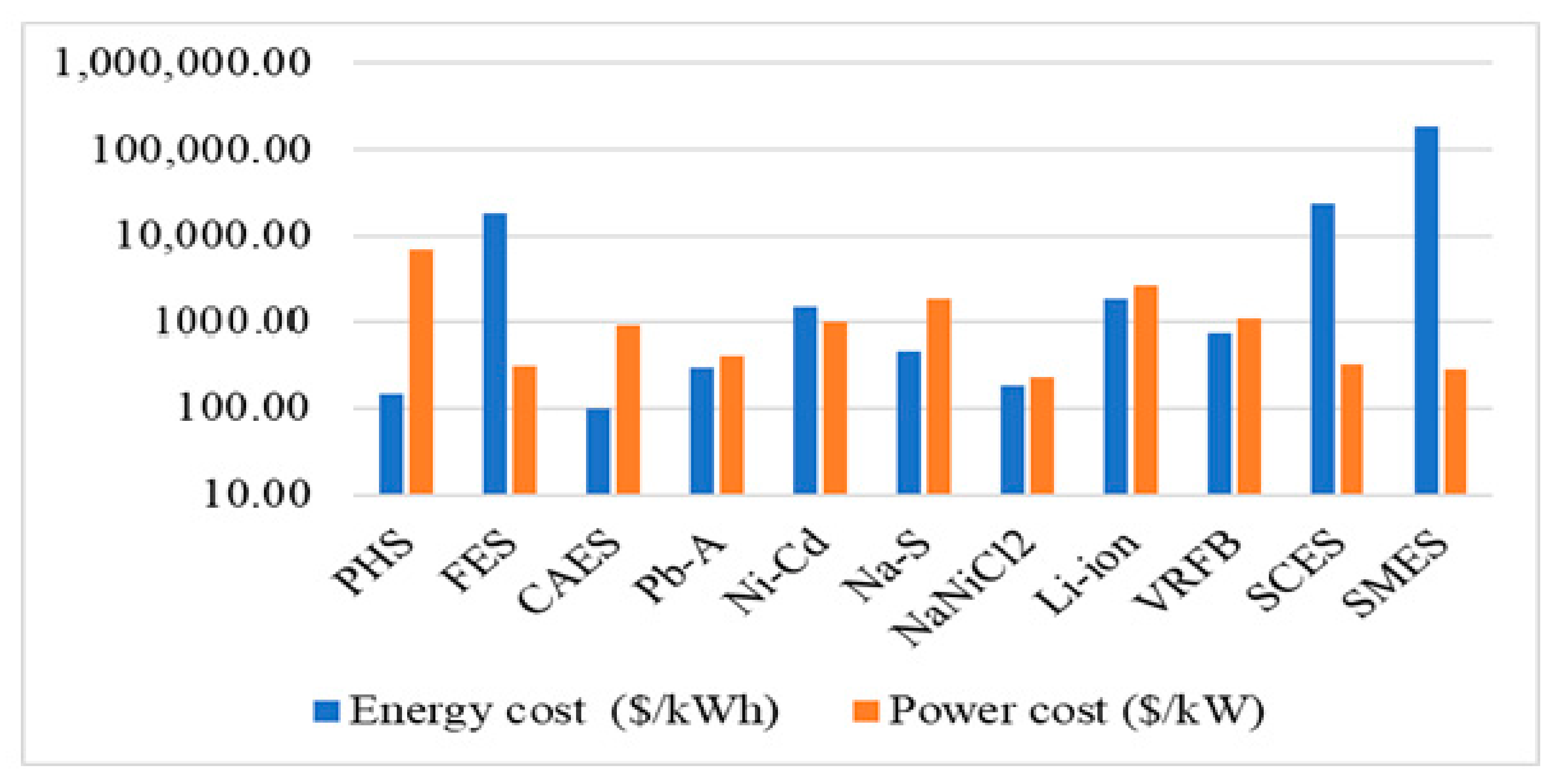
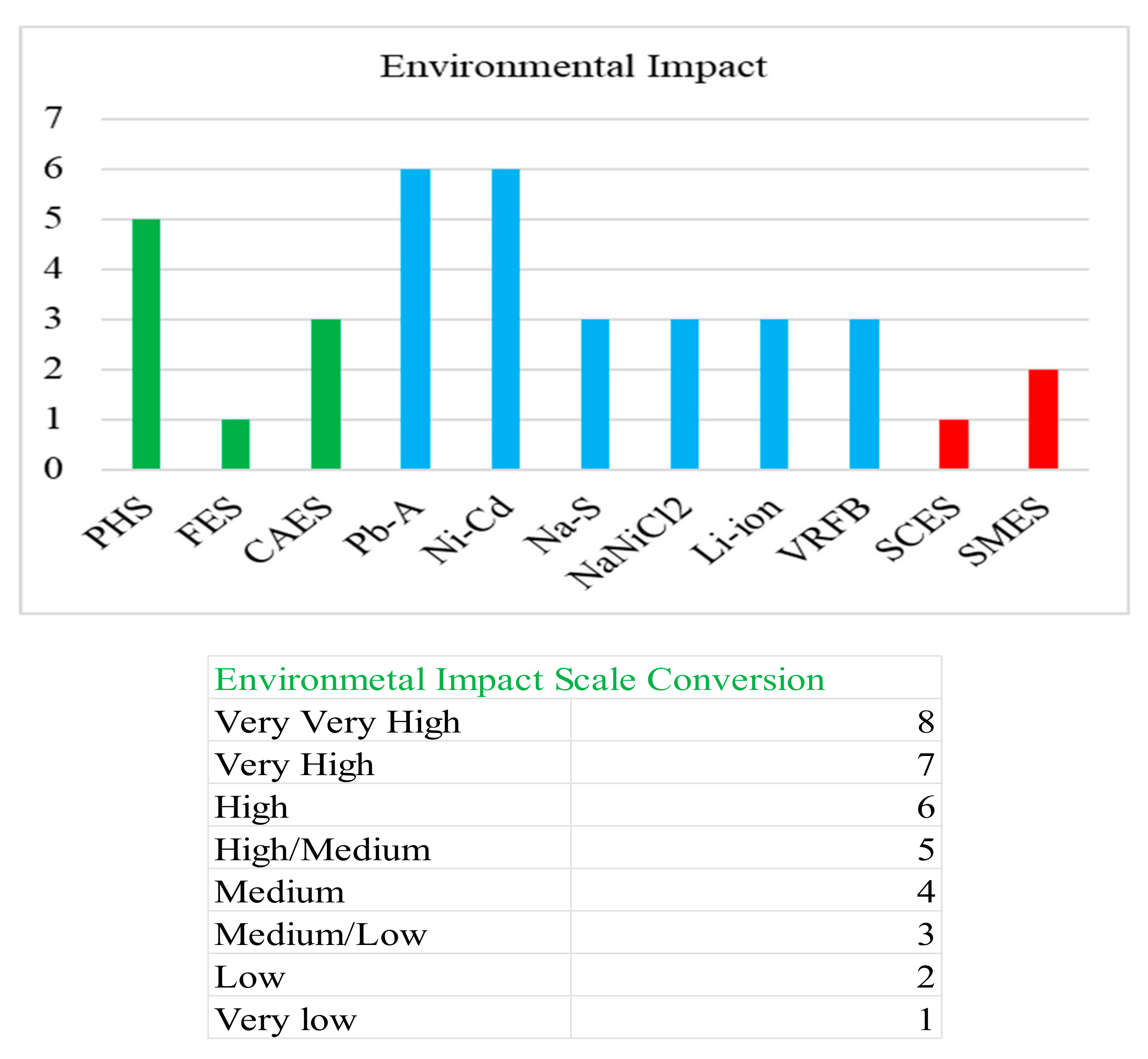
| Category | Applications | Storage Duration | Power Rating |
|---|---|---|---|
| Power Quality and Regulation | Fluctuation Suppression/Smoothing | ≤ 1 min | Small Scale (≤1 MW) |
| Dynamic power Response | |||
| Low voltage Ride Through | |||
| Line Fault Ride Through | |||
| Uninterruptable Power Supply | |||
| Voltage Control Support | |||
| Reactive Power Control | |||
| Oscillation Damping | |||
| Transient Stability | |||
| Bridging Power | Spinning/Contingency Reserves | 1 min–1 h | Medium Scale (10–100 MW) |
| Ramping | |||
| Emergency Backup | |||
| Load Following | |||
| Wind Power Smoothing | |||
| Energy Management | Peak Shaving/Generation/Time Shifting | 1–10 h | Large Scale (≥300 MW |
| Transmission Curtailment | 5–12 h | ||
| Energy Arbitrage | |||
| Transmission and Distribution Deferral | |||
| Line Repair | |||
| Load Cycling | |||
| Weather Smoothing | |||
| Unit Commitment | Hours-days | ||
| Load Leveling | |||
| Capacity Firming | |||
| Renewable Integration and Backup | |||
| Seasonal Storage | ≥4 months | ||
| Annual Smoothing |
| ESTs | Power Range (MW) | Energy Density (Wh/l) | Power Density (W/l) | Round Trip Efficiency (%) |
|---|---|---|---|---|
| PHS | 10–5000 [2,12,13,26] | 0.5–1.5 [12,13,14,26] | 0.5–1.5 [11,27] | 75–85 [2], 65–87 [12,26] 70–85 [14] |
| FES | 0.1–20 [2], < 0.25 [11], 0–0.25 [12,26] 0.01–0.25 [14] | 20–80 [11,26] | 1000–2000 [11,26] | 93–95 [2] 90–95 [14] 90–93 [27] |
| CAES | 5–1000 [2], 5–300 [12,13,26] | 3–6 [12,13,26] | 0.5–2 [12,13] | 70–89 [2] 50–89 [12,13] 70–79 [27] |
| Pb-A | 0–40 [2], 0–20 [12,13] | 50–80 [12,13] | 10–400 [12,13] | 70–90 [2] 75–80 [12] |
| Ni-Cd | 0–40 [2,13] | 60–150 [2,13] | 150–300 [2] | 60–65 [2] 85–90 [12] |
| Na-S | 0.05–34 [2] 0.05–8 [13] | 150–250 [12,26] | 150–230 [12,26] | 85–90 [2] 80–90 [12,26] |
| NaNiCl2 | 0–3 [26] | 150–180 [26] | 220–300 [26] | 85–90 [26] |
| Li-ion | 0–100 [2], 0–1 [12,13] | 200–500 [13,26] | 500–2000 [26] | 85–90 [2,26] ~90–97 [11] |
| VRFB | 0.3–3 [12] | 16–33 [12] 20–70 [28] | 0.5–2 [28] | 85–90 [12] 75–82 [27] |
| SCES | 0–0.3 [12,13] | 2.5–15 [26] | 500–5000 [26] | 90–95 [2,26] 95–98 [27] |
| SMES | 0.1–10 [12,13] | 0.2–2.5 [26] | 1000–4000 [26] | 95–98 [2,26] 95 [27] |
| ESTs | Discharge Time (ms-hr) | Response Time (ms-h) | Lifetime (yr) | Daily Self-Discharge (%) | Technology Maturity |
|---|---|---|---|---|---|
| PHS | 1–24 hr+ [2,12,13,14,26] | sec-min [2], min [11,14], 1–2 min [12] | 40–60 [2,11]–[13,26] | Very small [11,12] 0.00 [9] | Very mature/Fully commercialized [2,9,11,14] |
| FES | ms–15 min [2,14,26] | < 4 ms-sec [2], sec [14] | 15 + [2], 15 [12,13,26] | 100 [13] 24–100 [9] | Mature/Commercializing [9,11,12,14,26] |
| CAES | 1–24 hr+ [2,12,26] | 1–15 min [2], 1–2 min [12] | 20–40 [2] | Small [11,12,13] 0.00 [9] | Proven/Commercializing [9,12] |
| Pb-A | sec-hr [2,12,13] | 5–10 ms [2], sec [12] | 3–15 [2], 5–15 [12,13] | 0.1–0.3 [12,13] 0.033–1.10 [9] | Very mature/Fully Commercialized [9,11,14] |
| Ni-Cd | sec-hrs [12] | 20 ms-sec [2], sec [12] | 10–20 [2,12] | 0.2–0.6 [12,13] 0.07–0.71 [9] | Very mature/Fully commercialized [2,9,12] |
| Na-S | sec-hr [2,12,26] | 1 ms [2], sec [12] | 10–15 [2,12,26] | 20 [9,12,26] | Proven/Commercializing [2,9,12] |
| NaNiCl2 | sec–h [26] | < sec [28] | 10–14 [26] | 11.89–26.25 [9] | Proven/Commercializing [9,26] |
| Li-ion | min–hr [2,12,26] | 20 ms-s [2] | 5–15 [2,12] | 0.1–0.3 [12,13] 0.03–0.33 [9] | Proven/Commercializing [2,12] |
| VRFB | sec-10 hrs [12] | Sec [12] | 5–10 [12] | Small [12] | Proven/Commercializing [9,12] |
| SCES | ms–hr [2] | 8 ms [2], | 20 + [2,12] | 20–40 [2,12] 0.46–40 [9] | Proven/Commercializing [2,9] |
| SMES | ms–8 sec [2] | < 100 ms [2] | 20 + [2,12] | 10–15 [2,12] 1–15 [9] | Proven/Commercializing [2,9] |
| ESTs | Total Capital Cost | Environmental Impact | |
|---|---|---|---|
| Power Cost $/kW | Energy Cost $/kWh | ||
| PHS | 2000–4300 [2], 2500–4300 [11], 600–2000 [12,26], 500–2000 [14], 2171–4342 [18] | 5–100 [2,12,13,27] 1–291.20 [9], 217–271 [18] | High/Medium [2,9,12,13] |
| FES | 250–350 [2,12,26], 271–380 [18] | 1000–14,000 [2], 500–1000 [12], 1000–5000 [13,26], 200–150,000 [9] 1085–5427 [18] | Very low [2,9,12,13] |
| CAES | 400–1000 [2], 400–800 [26], 1411–1628 [18] | 2–120 [2], 2–50 [13], 1–140 [9] 217–271 [18] | Medium/Low [2,9,12,13] |
| Pb-A | 300–600 [2,13], 200–300 [12], 326–651 [18] | 200–400 [2,13,29] 120–150 [12], 50–1100 [9], 54–337 [18] | High [9,12,13] |
| Ni-Cd | 500–1500 [2] | 400–2400 [2], 800–1500 [11], 330–3500 [9] | High [9,12] |
| Na-S | 1000–3000 [2,13,26], 380–3256 [18] | 300–500 [2,13], 150–900 [9], 326–543 [18] | High [9,12] |
| NaNiCl2 | 150–300 [26] | 100–200 [26] 100–345 [9] | Medium/low [9] |
| Li-ion | 900–4000 [2], 1200–4000 [12,13], 1303–4342 [18] | 600–3800 [2], 300–1300 [12] 2000–4000 [9] 600–2500 [27,29] 651–2714 [18] | Medium/Low [9,12] |
| VRFB | 600–1500 [12], 651–1628 [18] | 150–1000 [12,29] 100–2000 [9], 190–1085 [18] | Medium/Low [9,12] |
| SCES | 100–450 [2], 271–480 [18] | 300–2000 [2], 100–94,000 [9] | Very low [9,12] |
| SMES | 200–489 [2], 200–300 [13], 217–326 [18] | 1000–10,000 [13], 5000–1,080,000 [9], 1085–10854 [18] | Low [9,12] |
Publisher’s Note: MDPI stays neutral with regard to jurisdictional claims in published maps and institutional affiliations. |
© 2020 by the authors. Licensee MDPI, Basel, Switzerland. This article is an open access article distributed under the terms and conditions of the Creative Commons Attribution (CC BY) license (http://creativecommons.org/licenses/by/4.0/).
Share and Cite
Behabtu, H.A.; Messagie, M.; Coosemans, T.; Berecibar, M.; Anlay Fante, K.; Kebede, A.A.; Mierlo, J.V. A Review of Energy Storage Technologies’ Application Potentials in Renewable Energy Sources Grid Integration. Sustainability 2020, 12, 10511. https://doi.org/10.3390/su122410511
Behabtu HA, Messagie M, Coosemans T, Berecibar M, Anlay Fante K, Kebede AA, Mierlo JV. A Review of Energy Storage Technologies’ Application Potentials in Renewable Energy Sources Grid Integration. Sustainability. 2020; 12(24):10511. https://doi.org/10.3390/su122410511
Chicago/Turabian StyleBehabtu, Henok Ayele, Maarten Messagie, Thierry Coosemans, Maitane Berecibar, Kinde Anlay Fante, Abraham Alem Kebede, and Joeri Van Mierlo. 2020. "A Review of Energy Storage Technologies’ Application Potentials in Renewable Energy Sources Grid Integration" Sustainability 12, no. 24: 10511. https://doi.org/10.3390/su122410511
APA StyleBehabtu, H. A., Messagie, M., Coosemans, T., Berecibar, M., Anlay Fante, K., Kebede, A. A., & Mierlo, J. V. (2020). A Review of Energy Storage Technologies’ Application Potentials in Renewable Energy Sources Grid Integration. Sustainability, 12(24), 10511. https://doi.org/10.3390/su122410511










